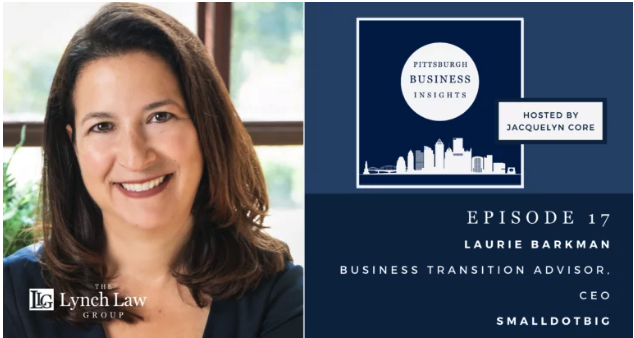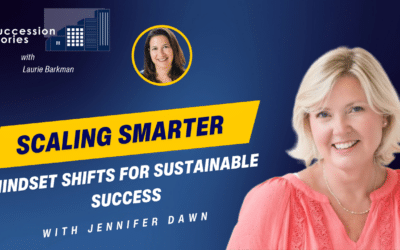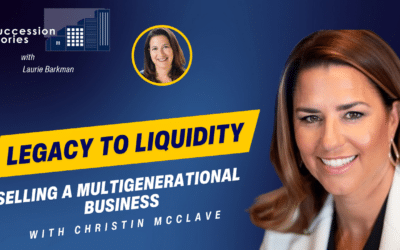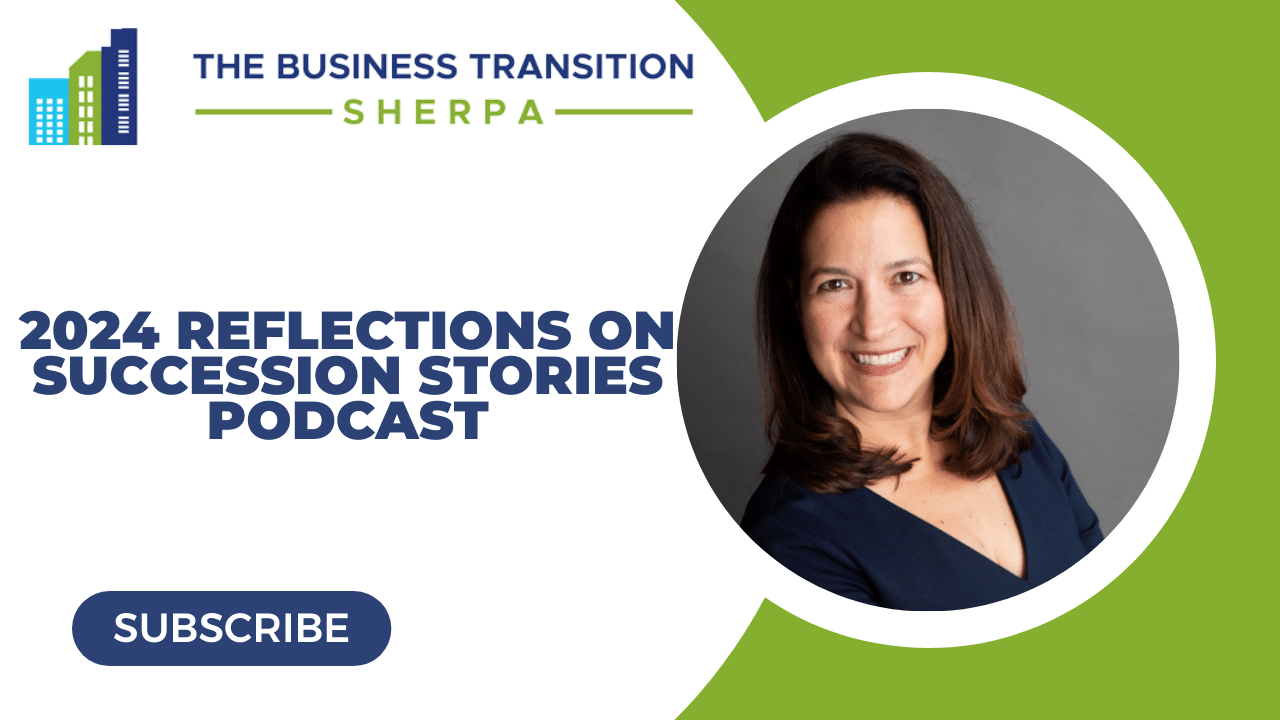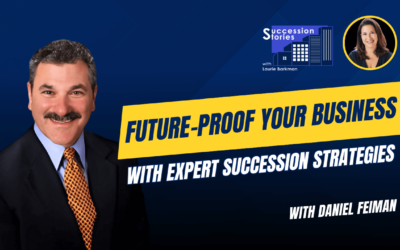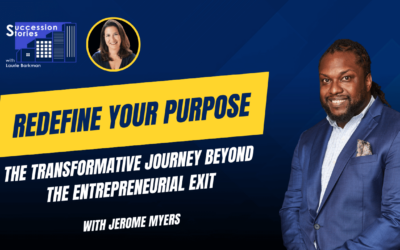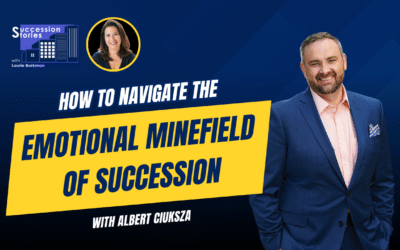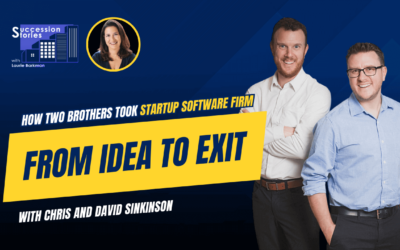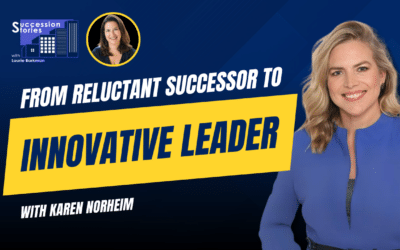How do I pinpoint a number that represents the value of my business? Is it too early to begin planning for a transition? Do I have the capital to begin planning? Can I maintain an active role in my company following my transition?
Laurie Barkman, Business Transition Advisor and CEO & Founder of strategic advisory firm SmallDotBig, has made it her career’s mission to answer these questions and more for small to mid-size business owners.
Laurie visits Pittsburgh Business Insights to discuss her expertise as an exit planner and Certified Value Builder, the distinction between professional and personal readiness to sell, and her own podcast series’ recent milestone.
Now streaming on Spotify, Apple Podcasts, and Google Podcasts.
About Laurie Barkman
Laurie Barkman is CEO & Founder of SmallDotBig – providing value creation advisory for mid-market businesses. Laurie brings more than 25 years of experience innovating and building company value. Advising entrepreneurs to achieve their goals means sharing what she’s learned as a CEO, Carnegie Mellon adjunct professor, and go-to-market executive in startups and corporates across various industries. Laurie is also a podcaster with remarkable insights from business leaders and thinkers on her weekly show, Succession Stories.
Laurie earned an MBA from Carnegie Mellon University, BS from Cornell University, Certificate in Exit Planning, and is one of only four Certified Value Builder™ Advisors in Pennsylvania. Laurie is also a certified Vistage speaker and presents value creation workshops to CEOs around the country.
About SmallDotBig
Entrepreneurs don’t start and build their businesses on their own. And neither should they plan their exit or succession strategy on their own. When it’s time to move on and into their next personal or professional venture, SmallDotBig helps business owners get rewarded for their hard work when they sell.
Laurie works with owners to set your path for success if you’re anticipating a sale or ownership transition in the future. That means increasing the value of your business and empowering you to begin your next professional or personal venture.
Connect with Laurie Barkman
Laurie Barkman
About Pittsburgh Business Insights
Starting a business: three words that require plenty of planning. On Pittsburgh Business Insights, Jacquelyn Core, a partner at The Lynch Law Group, interviews Pittsburgh entrepreneurs and uncovers what makes business boom in the Steel City. Whether you are growing your own company, looking to improve your practices, or simply interested in the advice of Pittsburgh professionals, tune in for ideas and inspiration from some of Pittsburgh’s top business leaders.
Transcript
Intro:
Welcome to Pittsburgh Business Insights. My name is Jacquelyn Core and I’m a partner of the Lynch Law Group and the Corporate Practice Group and I want to thank you for joining us. Pittsburgh Business Insights is your podcast to meet the movers and shakers in Pittsburgh business, dive deep with businesses in the region to learn about business developments and get inspired to take your business to the next level, so, let’s do business.
Jacquelyn Core:
Welcome to today’s episode of Pittsburgh Business Insights. I am so excited because my guest today is Laurie Barkman and Laurie and I have a lot in common and really enjoy talking with each other and I’m excited for you all to hear about what she does and to hear from her today. Laurie is the founder and CEO of SmallDotBig, a company that provides value creation for mid-market businesses. She has more than 20 years’ experience helping companies build value, she has prior experience as a CEO, and I always think my C-suite experience makes a really big difference so that’s a great value add and happy to talk with her a bit about that today. She has worked at Carnegie Mellon as an adjunct professor, she’s also been a go-to-market executive in startups so really broad-based corporate experience, and, like me, Laurie is a podcaster. She has an amazing podcast called Succession Stories, if you have not checked it out you should definitely check it out, and, it is your one-year anniversary today when we’re recording, correct?
Laurie Barkman:
That’s correct. Thank you for mentioning that.
Jacquelyn Core:
Yes! Congratulations.
Laurie Barkman:
Thank you.
Jacquelyn Core:
It’s been so much fun to follow your podcast and listen to stories of generational business owners. It’s fascinating and just really inspiring, so listeners, check that one out as well.
Laurie has an MBA from Carnegie Mellon as well, her undergraduate degree is from Cornell and she is a certified exit planner. She is one of only four certified Value Builder advisors in the Commonwealth of Pennsylvania – big state, so very accomplished. She’s also certified as a Vistage speaker and presents value creation workshops around the country to C-suite executives and other business owners, so, welcome to the show.
Laurie Barkman:
Thanks Jacquelyn, I’m really excited to be here and congratulations on the launch of your show.
Jacquelyn Core:
Thanks so much. It’s just been so much fun.
Tell us a bit more about SmallDotDig, and I would love to hear along with that the story of why and how you started this company.
Laurie Barkman:
The big word for me is ‘transition’. I think it’s that word we fear. We fear change, so many of us fear change, but it’s inevitable – change is going to happen. Whether or not you plan for it, it’s coming, and so that’s one of the things that’s really the inspiration and the foundation of my firm, SmallDotBig. There’re a couple of things behind the name, thank you for asking. It’s kind of tongue in cheek because if you’re familiar with billiards and pool, and you’ve played pool in the United States, we know solids and stripes, but if you play with someone from Australia or New Zealand as I did, they call it small dot or big dot, and it’s one of those things you can’t unsee, and so I think that’s one of the things in business or in life when someone points something out to you that you hadn’t recognized before, and you’re like, “Wow, I just had not thought about it that way,” that “A-ha!” moment, and this idea of having people around you who can provide you with insights to make a difference in your life or in your business. The differences that we aim to make are around innovation, growth and transition.
Ultimately, entrepreneurs don’t start and build businesses on their own, and neither should they plan for their transition or exit strategies on their own. That’s one of the fundamental tenets that I believe in and so when it’s time for them to move on and think about selling their company, which they’ve worked so hard to built, it’s a very complicated decision, it’s fraught with a lot of emotion as we all know, and it’s not just about the money. Of course, it’s important to help them achieve their goals on the exit, financially, but it’s also very important emotionally and for them personally, whether it’s because their name is on the door quite literally or figuratively, so many people have this identity wrapped in, so the idea behind SmallDotBig is certainly in the name – from small to big – the growth element. I think to transition you have to prepare for change, so that’s seeing things a bit differently and having some trusted advisors on your side – that’s what I aim to do.
Jacquelyn Core:
Now I love so much that you focus not just on the growth of the value of the business but also on the personal aspect and helping people be personally ready for this transition. Doing M&A work, I see so many people that really are struggling with the exit of their business. They’ve made a decision, it’s probably the right decision even, but that doesn’t make it easier, and so there’s this sense of… almost a sense of loss when people are turning their businesses over to new owners or they’re exiting a business that they’ve built even if they’re excited, even if its because they’re getting a great exit or someone’s made them an amazing offer that they just couldn’t refuse, there’s still this sense of, “I’ve put my heart and soul into this for so long, and now I’m walking away from it,” and so that you also help people through that more human element that we see doing M&A work, walking with clients and holding their hand through that sale process and making sure that their transaction goes smoothly, I think a lot of people don’t see or recognize that.
Can you talk to us a little bit about what that personal planning looks like?
Laurie Barkman:
Personal planning starts with figuring out what their goals are, and sometimes those goals are really apparent to them. They have an intent to be in the grandparent business. I talked to one woman recently, she had built her company with her husband for thirty years and she has taken a well-deserved step back and I was asking her, “What are you excited about? Do you want to sit on boards? Do you want this or that?” She says, “No, I just wanna do nothing. I wanna be with my granddaughter and I want to think about it,” so she has that element of time which is so important. That’s something you can’t get back, time, and so how do you want to spend your time? We talk about that.
I have another client that doesn’t really want to separate after she sells her company, she wants to stay involved, maybe in just less of an operating role. There’s another gentleman that I’m working with and he’s built his business for 20 years. He’s in his 60s, he definitely wants to step out of the day to day but he’s open to the transition. He wants to see it succeed going forward with the new owner. Some people want out right away, some people want to stay involved in some manner, as a consultant, and others… they’re not sure yet, so you can have a spectrum of what your needs and wants are. What I try to do is work with them on baselining against a readiness assessment, this personal readiness to transition or exit your business, and there’s four core drivers that go into that assessment.
Then, we give them some thought exercises to flesh out more specificity. If you answer one question and it’s a radio button, you’re choosing ABCD. Okay, great. That took you 30 seconds to answer that question, or did you really spend an hour or two or three, thinking about what comes next after you answer that question? For example, we’re talking on this theme of what will you do once you intend to leave? Or what’s your timeframe? There’s some things we can really talk about, and you can rush it and say, “Oh, I did that, I worked on that. I talked with Laurie about it for five seconds.” Okay, well, what I like to do with folks is, I work with them on the business readiness and I also work with them on the personal readiness and so what percent of time in our advising sessions is split between those will depend and it can flex and come back and forth. I think primarily, it depends on the client situation, but the focus typically, is getting the business ready.
There’s this concept in psychology called cognitive dissonance. I don’t know if you’re familiar with that term, or if the audience is familiar with it. I’ll explain it as best I can but it’s kind of like, if you believe in something, and you’re participating in it that makes sense, right? Because you believe in it, and you’re participating. But let’s say you’re participating in it, but you don’t really believe it. Well, the more you participate, the more you start to believe and so that’s the concept of cognitive dissonance and I think what helps people, imagine you’re selling your home, you’ve lived in your home for 20 years, you’re kind of sad, but once you start to really prep and paint and clean and get the house ready and listed with a real estate agent, you’re kind of there. Now the key thing is how do you sell that home? Or how do you sell that business? How do you make this transition without regrets? That’s very complicated, but it starts with really being on board with the process, being involved in the process, understanding what it’s going to take and letting yourself kind of go with it. That’s a big part I think, from a psychology standpoint.
The other part is the readiness side of knowing what’s behind that door, so if you’re imagining this exit, you’re about to go through this door, you don’t know what’s on the other side. What are you going to feel? You’re going to feel trepidation, you’re going to maybe feel scared, emotional roller coaster thinking about all the people around you. You have concerns for yourself, your concerns for them, okay, so we have fears, how do we unpack those fears? What do we do with those fears?
I think like many people I know, for me, I write things down, if I have a plan, if I’m working with people who are advising me on a structured approach makes me feel more assured of what I’m doing. That’s part of it, right? Feeling like you know what’s coming. If you have a medical treatment, and the doctor is advising you, and you’re feeling all sorts of trepidation about it, but your medical doctor’s advising you, this is what they do, you feel better about it. You still have to go through the process and it’s not that dissimilar here, I think, because it’s not a one day activity. A lot of times, it can take one to two years for a business to be ready to be sold, when you’re really focused on selling it. Personally, you think about that time, that one to two years of time, you are involved in that process, you’re personally getting ready, but what’s behind the door? I call it the push versus the pull. Are you being pulled into something next, like I want to spend time with my grandkids, I want to travel the world, I want to start another company, I want to serve on nonprofit boards, or independent boards, public or private companies, I want to do these things whatever that is.
There’s a story I’d heard about a woman who sold her company and she decided to pursue her passion for art, and became a very well known person in certain circles and Paris, and she travels the world and that’s fulfilling her and she’s in her 60s. There are people who have no time for hobbies, because their hobby has been their work. This is a door opening opportunity to really say, “What is this for the next chapter of my life?”
Whether you’re in your 60s and expecting to put your feet up, and you don’t want to have one more shot at this or maybe in your 40s or 50s and you’re saying, “Hey, I’ve worked really hard on this, and I want to go do something else. I got another business in me.” The answer for everybody really, really depends. I think the support of your other owners, if there are other owners, their involvement in the process, your family, at some point, the right point, not the immediate point is your team and involving them in it. That’s part of our discussion is when to involve all those parties at the right time because obviously there’s confidentiality and so many things, you have to talk about the process, you have to work through the process. That’s what I call the IQ and the EQ side of this, Jacqueline, because it’s complex.
Jacquelyn Core:
Well, and you know, I think it’s so helpful for us when we get to the transaction stage where somebody has worked with somebody like you, because this all impacts actually your deal structure, right, and so you’re helping people define their deal structure before they get to that stage and so people who come to us and don’t even know earnout as an option, they haven’t had the time to process. Maybe they thought they were leaving and now somebody says, “Well do you want to stay on as a consultant,” and it’s jarring, and you can see this impact on people like, “This is not what I planned, and now I don’t know what to do,” and it might even be that it’s a better option, but they’ve never explored it, they’ve never had a process surrounding it. I think to be in a place where you have that process, and you can help work through that and really internalize some of those things and make decisions that are not spur of the moment and that aren’t the decision that you say, “I hope that was the right way to go,” but you have had some thoughts around it and some time and you’ve been able to talk to your own trusted advisors, your family, your friends, “What’s a good fit for me,” and to make make those plans.
It’s dynamically different once you get to the actual sale process to have had the benefit of a process like the process you take people through. I wanted to key on something that you said, you talked a bit about the length of the process and I think the other thing that people sometimes don’t think about, and maybe it’s difficult to think about, in some ways selling a business maybe is like estate planning that some people don’t want to think about their estate planning because they don’t want to think about their own death, and so you don’t want to think about the sale of your business because you don’t want to think about the time when your beyond it, but then what happens is you haven’t allowed yourself that time, so can you talk a little bit about the timing that you recommend that people should allow to go through this kind of generative process to get ready?
Laurie Barkman:
I think that in the big picture, what are we really talking about? We’re talking about value creation, which is making your business more valuable. Who doesn’t want to have a more valuable company, regardless of what your transition outcome is going to be? It’s just like investing.
If you’re going to be saving for your retirement and putting money in your 401k you’re not going to wait to start investing, hopefully, right? People like myself who had the ability to invest in a 401k right out of college, I was fortunate to have that opportunity and my husband did as well. You put a little bit away, you put a little bit away and then the magic of compound interest and then hopefully one day, when I’m ready to retire, I’m going to look at that and say, “Wow, that’s a pretty amazing thing that I had.” Well, why not look at your business the same way, so the work that you would do today, to prepare your business for sale is essentially building value in your company.
Now, the ‘when’ I’m going to kind of hone in on specifically, creating an exit strategy, working with a trusted advisor team, and so on. What I’m seeing Jacquelyn is that there’s kind of this five year mark. I have a survey called the Value Builder survey, we use it to assess business readiness. I have people taking the survey that are saying, “I’m ready now,” and I have people that are saying, “I’m ready in 15 years.”
Regardless, you can still answer these questions and get a good assessment of where your business is, through the lens of a potential acquirer meaning we’re looking at your business on eight different value drivers.
At the end of it, if they’re providing some of the financial information, we can provide an estimate of value. What’s really interesting about that is a lot of business owners have no idea what their business is worth. Now, why would you wait till the end to understand what your business is worth? It’s also important here to note that you need to sort of have a sense of these all fit together, they talk about the three legged stool, you have the personal, financial, and the business.
For a lot of business owners who’ve amassed a significant business, let’s say $10 million or more in revenue, perhaps 80% of their net worth is tied in to this one asset, this big asset, but it’s not liquid. They can’t take the money out, so they’re not diversified. We’re talking about portfolios, investing. Talking about having a diverse portfolio, well, that’s not really diverse, when you look at your total picture, you have your house, and you have your company and you may have other investments, well you’re not really diversified in your portfolio so at that time, when you’re thinking about, “What will I need in my retirement, what type of lifestyle? What does wealth mean to me,” and by the way, because of the pandemic, the Value Builder system, which is the company that I licensed intellectual property from, they’ve done an amazing job at reaching out to more than 55,000 business owners who use the platform around the world with a focus on North America.
Most recently, there was a survey done last year, which is 2020, pre-pandemic data and then during the pandemic data, we can’t say “post”.
Jacquelyn Core:
It would be nice to say “post”.
Laurie Barkman:
It will be nice to at some point, say “post” and I’m sure we’ll measure it again, but let’s call it a six to nine month difference in time. There are a couple different questions on the survey. One was ‘how do you define wealth?’ and the definition of wealth, we did see a shift where the previous question was my net worth of 10 million or more and it shifted into more of an answer around ‘to be able to do what I want, whenever I want’. It’s really around time, and flexibility and control. I think that’s one thing is, you could be the guy that’s in your 30s and sell your company for not a lot of money, and be very happy living on a sailboat sailing around the world and that’s a true story. I don’t remember his name, but that did happen and it’s not going to be the biggest multiple in the world, or the biggest dollar value, but it’s what he wanted, it’s how he defined his own success.
If we come back to our client situation here and say, “Okay, well, you know, what are we starting to think about goals? What financial planning should we be doing,” and involving, if they have a wealth manager, to be talking with a wealth manager, and I partner with wealth managers also, I’m sure you do too Jacquelyn as part of this trusted team, to help them understand what their needs are, and after tax consequences, and what’s the net number, if they sell their business for this magic number? I call that the envelope test if we said, “Okay, what do you want to sell your company for? Write it down, put it in an envelope and put it away in your desk and one day, when we come back, and we’re ready to have this conversation about what do you want to sell your business for,” or, If you have an offer, and you want to consider pull out that envelope because you’ve probably seen when you get so close,” and maybe there’s even deals where people walk away for a relatively small amount, because they’re emotionally charged or they’re frustrated, they’re not getting the number that they perceive that they should have yet it might be a lot higher than what was in their envelope test.
Jacquelyn Core:
I do see that and something else you talked about, the importance of working with a wealth manager. There’s a couple of sides of that coin. I think wealth managers are great at helping people understand how much money they need and what that looks like, in accordance with their goals if you have a really good wealth manager but often we’ll hear people value their business by what they need to retire and so you mentioned people not knowing what the business is worth. Sometimes we’ll hear people say, “What do you want to sell the business for?” And they’ll say, “Well, when it’s all said and done, I need to get 2.4 million. You say, “Okay, well, where did you get that number?” It’s like, “Well, that’s what I think I need to retire,” like, all right, but there’s no reasonable relationship to the value of your business. I mean, let’s hope coincidentally, it does, but we’re not valuing your business based on that, really bringing people kind of down to Earth on that, helping them understand what do you really need but then what’s the business worth?
The other thing that you mentioned that we see all the time is people who have, from a lean operations standpoint, they’ve stripped a lot of value out of the business, and so they’ve reinvested profits, they’ve taken really heavy deductions that there’s no problem with, everything’s aboveboard, those deductions are 100% appropriate but when it comes time to look at the value of their company, they’ve stripped it of a lot of its value, from an operational perspective. Maybe 10 years out, that might be a great strategy but I think the real thing is that you can help people understand the shift that needs to happen, from how you might operate your business, five to 10 years out from sale, and how you might operate it three to five years out, to try to make those increases in value.
Often we’ll see somebody decided the last minute they want to sell, or they’ll get an offer but then when the people look at the books, the EBITA just isn’t there, it’s just the numbers don’t support the value of the business, and a lot of times business owners will say, “Well, yes, but if you look at all these deductions I took or if you look at the stuff I bought, or if you,” and buyers aren’t going to do that. It’s just not an evaluation most buyers are going to make.
Laurie Barkman:
Right, and that situation maybe becomes an asset sale, so we value the equipment, we value the buildings and I think a lot of businesses that are under 5 million are probably in that category where it may not be an equity deal, maybe an asset deal.
Jacquelyn Core:
Yeah.
Laurie Barkman:
That’s going to be a very different number than what they might have been expecting.
Jacquelyn Core:
What role do you play in helping people understand what the business is worth, and then also in helping them increase the value of that business?
Laurie Barkman:
I see my role as an advisor to help them understand and educate where I can, and coach, so it starts with this assessment of, as I mentioned about the business, let’s assess the business, let’s baseline where you are today, across eight core value drivers. I won’t go through all eight, but as an example of one of the value drivers, and I’m sure this won’t surprise you or some of your listeners who can maybe relate to this is, the more the owner of the business is tied in with sales, or product or service delivery; they know customers by first name, customer service feels great customers love them, but at the same time, they become the only person who really can deliver upon this product or service because they’re the ones that know the customers’ needs. We call this the owner’s trap where the business is so dependent on the owner in so many ways, maybe it’s other processes, whatever it might be, the owner’s trap.
As a consequence, a business that cannot thrive without its owner is not worth very much. You asked me earlier about this transition of the head and the heart, how do you start to work with an owner, and that’s why I said this five year number is coming up a couple of times, and I’ll share some statistics on that in a moment.
But I think that when someone is starting to really get serious about things, about this transition, and if they don’t have a 2IC, a second in command, then it’s even more complicated so yes, they’re going to have to be investing in infrastructure. It’s kind of like selling your house. Again, I know we talked about that before, but if your house is being evaluated, versus your neighbors and your parcel’s relatively the same size and the construct of your house is relatively the same, what’s gonna make you different or unique?
This, what I call monopoly control, there’s differentiation that you have in the marketplace. For Warren Buffett, he calls it the moat. What’s this competitive moat you have around your business? Are we really clear about what differentiates your company? Are we clear about your financials you hit on that earlier, and what your past three years looks like, as well as your growth opportunities in your industry or geography? What’s that potential? Is there a field left to plow if someone’s gonna buy you?
We also look at what we call the Switzerland Structure, which is this neutrality that you’re not too dependent on one person, which could be you. You’re not too dependent on customers. No one’s comprising more than 15% of your total revenue, which is kind of a risk and concentration there. Likewise, on the supplier side that you don’t have supplier concentration We look at all these different factors, there’s a few more things, but that’s kind of the general gist of it, I mean, certainly having also this predictability of future cash flow so the more percent of revenue your company has in a subscription model or recurring revenue not re occurring, to be different there. Recurring, where you have your setup for predictable payments from your customers, we look at all of that.
Now, you might say, “Oh, my customer satisfaction scores are great, my Yelp is good,” and this and that. Well, what if we really get under the covers and understand, well, we’re not really measuring, it’s just anecdotal and we are finding that we’re having customer support issues, we need to work on that. Or likewise, we’re finding that we’re not pricing, maybe that we’re leaving some money on the table on revenues, because we’re not pricing it the way we could be. Maybe we’re not pricing based on the differentiation we have, or the value added we’re providing so it’s kind of a blend of go-to-market and operational effectiveness, to really understand how the business has been operating and where there are opportunities to really hone in and differentiate, so that when you’re presenting your company, when you’re ready to present your company, whether it’s a strategic buyer, or a financial buyer, you know what those key features are, and some of the tangible things that we can see in your business.
Great, let’s make sure that it’s a clean environment, you have signage, if you’re familiar with S5 is a terminology for signage, everything’s labeled, and we have intangibles, so your customer list and you know, what your website is showcasing and how up to date things are: your processes, your software, and there’s a whole list of things.
All of those are decisions about, “Do I want to invest that capital back to the 2IC?” Do you have a team around you, so that if you’re not there in your business, for three months or more, things don’t stagnate, your company’s sales stop, there’s no pipeline development, because you’re not there. Those are all things that can hurt your predictability of your future cash flow, which is again, gonna then hurt your valuation.
Jacquelyn Core:
We see a lot of that. One of the ways to exit your business, of course, is through a key person transition, right? Some people sell their business to their second in command, a lot of people don’t have a second in command so you look around, there’s nobody we could sell this thing to, because it’s just me, and to your point about, “We’ve got great Google reviews, we’ve got great Yelp reviews,” but if all those begin, ‘Bob is awesome. Bob takes care of everything’, is that part of your value, built also on that real owner dependence?
I think we see that a lot in businesses that were kind of grown from the ground up in particular, where maybe early on as a startup, people had to do everything themselves, you have to be a one man band, you’re doing the books, you’re the one posting on Facebook and trying to build a social media presence, and you’re taking care of customers, and you’re making deliveries and you’re…whatever there is to be done, you’re running the vacuum at night before you leave, because there isn’t anybody else to do it.
Some people don’t ever transition out of that and so, even if you’ve been doing it that way for 20 years, in those last years before you’re ready to sell, it’s never too late to make that transition. It’s not like, “Well, I never let go of that stuff so I’ve got to do it to the very end,” but helping people really understand that, and I think a lot of people don’t even realize that builds value, they don’t realize that value is tied in any way to that interdependence.
Laurie Barkman:
They may not. There was one woman I spoke with, and we did – she did the Value Builder assessment and it showed a really great potential. It was like 150% increase in potential, if we were able to move the needle on her score, which is, call it an average zero out of 100 points. Typically, what we see for companies is they’re 54-55. and so the more we can move the needle, the data shows from these 35,000 companies that are participating in this process, if we can move the needle from 50, in the 50s, to the 80s, we can increase – on average we’re increasing the multiple by more than 70%.
For some companies that’s quite significant, as you can imagine, right? So we baseline you now and we say, “Hey, let’s prioritize. Out of these eight drivers, there’s three or so that we need to prioritize.” We create an action plan for the next six months or a year to be working on these things, and then I work with them, as their advisor, as their value creation advisor, and I’m meeting one on one with the business owner or owners if there’s more than one. I’m also involved with their team if they have a team. It’s really valuable, I think, to come at it from both sides, because there’s the stuff as I say, you don’t want to put it on Front Street quite yet.
It’s the private conversations that we are having to say, “Yeah, you’re anticipating to transition in seven years,” but we don’t need to talk about that with their 2IC or their management team now, that’s a little bit too soon, but we need to talk about it. What we do want to talk about with the with the management team is more of strategic planning and so I use the input from from this assessment to understand what the big rocks are to pull that language from Stephen Covey originally quoted it, to say, “What are those big things that we need to work on?” Whether it’s financial performance, whether it’s creating a recurring revenue model, whether it’s the Hub and Spoke problem, which is this owner’s trap, whether it’s getting more independence through working on the Switzerland Structure needs, and so on and so we prioritize, and we can kind of look at, well, if we move the needle, we’re able to improve financial performance and improve EBITDA, we’re able to improve the measure is across these eight drivers, then we can we can do scenario planning of well, what might that multiple be based on your industry segment? It’s got a competitive comparison in there too, which is really valuable.
Jacquelyn Core:
So how often do they get that score? How often do you redo that?
Laurie Barkman:
Annually.
Jacquelyn Core:
Okay, yeah, so I was thinking like, boy, you could do that every day.
Laurie Barkman:
Yeah. No, it’s like checking your blood pressure, like, okay, you want to know, but yeah, “I’m generally healthy.” But no, it’s not productive to do that every day so it’s like an annual checkup, though for the business. It’s an annual checkup for the business.
Jacquelyn Core:
There’s a plan in place, “What do we need to do,” and then I’m assuming, that might mean that you’re going to, you’re maybe going to shift to a different [part] of the eight value drivers if you’ve made real progress in one area, or tweak your plan to like to continue to increase as is appropriate.
Laurie Barkman:
Yeah, absolutely.
Jacquelyn Core:
One of the things that we have talked about recently that I wanted to touch on with you, was this shifting exit timeline that we’re seeing with business owners.
Laurie Barkman:
Yeah.
Jacquelyn Core:
Can you talk a little bit about that, because the time for exiting businesses, we’ve seen a real shift?
Laurie Barkman:
We’ve seen a real shift. Yeah, we have. I think it’s not surprising, given that last year, 2020, with the pandemic, it has been difficult and exhausting for a lot of people and especially, I think what we’re seeing for the lower middle market, privately held companies, if they’ve been in business now, for 30 years, they’ve gone through this transition through three recessions, and they’re tired, and they’re ready to sell.
This survey data that I shared earlier, one of the other questions asked them, and we did this comparison of prior to COVID timeframe, “What time horizon do you have to transition your company?”, and it was under five; five to 10, 10 plus, and in the past, it was favoring 10 plus, and what we see now is a shift into the less than five.
Jacquelyn Core:
I hear sellers keep talking about they just have COVID fatigue, and so it’s like we get these infusions of capital from PPP or EIDL loans, or whatever the case might be, and we rebound a little bit and things open, and then things get locked down a little more. We, of course, hope that with vaccinations increasing now that we’ll really be in a place where we’re on an upward trajectory, but at the same time, a lot of people were just really tired from it.
I’ve heard a couple of owners say recently, “It would take a couple of years to rebuild my business,” and maybe like, “I plan to work three or four more years, but it would take two to just rebuild and I’m just not willing to do that.” Yeah, so they’re going to make a sooner exit or an earlier retirement, just because they know the work that’s going to be ahead of them to try to regain their market share, or get customers back or reopen distribution lines, or whatever the case might be.
Laurie Barkman:
Yeah, it’s also interesting, going back to the when you talked about my introduction, and the work that I do at Carnegie Mellon. I work as an adjunct professor for a class called the corporate startup lab and it’s a class on corporate innovation. We work with master students in a capstone type of format, where we have companies sponsoring the class and these are companies that are typically mature, well-established, some of the publicly traded companies, some of them are mature family-owned multi-generational businesses, and they want to innovate. They want to develop new lines of product, new lines of service, maybe you’re looking at corporate venture capital.
The point is that disruption risks all of us at any time but I think the pandemic accelerated for some companies a disruption. They were not prepared for a digital transformation. Some companies pivoted very, very quickly and then there are so many amazing stories about companies putting together or getting third party systems in place to continue to deliver products and services, whether it was food, and restaurants. A lot of restaurants, just as an example, didn’t have a loyalty program so they didn’t have a way to communicate with their customers on a regular basis. The ones that did had an easier time to communicate and say, “Hey, we’re open and we’re open for takeout,” and then you saw, B2B companies pivoting to B2C and they needed to create an ecommerce platform.
On my show Succession Stories that you mentioned earlier, I had talked with a betting company, their core was wholesale B2B and about a year before the pandemic, they had launched a B2B business. They just had the foresight to do it, that worked out, well guess what? Well, I interviewed her during the pandemic and she said her B2C business was growing quite substantially. The examples go on and on.
You could even look at an Amazon for example, where they talk about Day 1. What is Day 1? Well, Day 1 is all about the growth and innovation that’s going to come forward. Well, what’s Day 2? Day 2, if you listen to the speech by basis, he’ll say, “Well, Day 2 is when we’re being disintermediated and we’re being disrupted, so that’s why we focus on Day 1.”
I don’t think a lot of companies who have been around for a few generations necessarily feel close to their entrepreneurial roots. They may not have innovation processes, they may have felt disruption more acutely and so all of those things go into well, what’s next.
If luckily, or by hard work your business has survived the tough times, 2020, you are looking to continue to invest and innovate, continue to do that. There’s some data out there from Harvard Business Review, and others that say, “Keep investing.” it’s the right thing to do for your business, too. Don’t pull back on the R&D initiatives, don’t pull back on investing in new lines to stay competitive. Because for the rest of us, it’s always Day 2, right? That’s, I think, an important part of continuing to create value in your company. If your time horizon’s one or two years, okay, you’re most likely not in that in that in that camp, but if you are 5-10 years out, you’ve got to really maybe look at the pandemic situation and say, “What did it teach us, and what do we want to do differently to make sure that we are a sustainable company?”
Jacquelyn Core:
Yeah, and, you know, you bring up an excellent point, Laurie, because I think a lot of people look at the sale of their business, about getting their business to survive to the point where they’re really willing or ready to sell it and really, that’s not it.
You can’t just be surviving at that point. You’ve almost transitioned into being a lifestyle business at that point, and the value of your business just plummets and so getting people to think about, “Okay, if I’m gonna be ready to sell in three to five years, my company’s to be at its best in three to five years.” It doesn’t just need to have survived that time, but it needs to be still poised for growth, it needs to be still innovating.
Laurie Barkman:
What’s gonna make your business attractive, or your financials attractive? Is it a certain IP that you’ve developed? Is it your customer list? What’s differentiating you? Then a value can be assigned to that. Maybe it’s just real estate. You’re in a great location that somebody else wants to snap up, but the rest of the business doesn’t have a lot of value associated with it. That may be the case in situations where there’s multiple owners today. The silent partner might see this as a great investment opportunity, because they’re pretty close to the business and they see the potential and that’s a different conversation than when someone who’s completely outside, a third party, maybe it’s a competitor. In that case, it could be a competitor, that’s a strategic buyer or someone that is in the value chain or supply chain, that would see your business as a strategic tuck in acquisition. I think those scenarios, as we said earlier, really will depend on the situation, but an investment in today should be an investment in your outcome, and building value. How you weigh those things can vary, and you certainly need to do the cost benefit analysis.
Jacquelyn Core:
Thank you so much. You shared so much information with us. You talked a little bit about you know, what’s the secret of your company’s success, I want to just turn back to your company, to SmallDotBig because you have experienced growth and people reaching out to need your services. What’s one thing that’s really helped you maybe create that moat or distinguish yourself as a company?
Laurie Barkman:
I think one thing that distinguishes my firm, SmallDotBig, from others that are trying to help companies build value, is we’re focusing on where they are today in a couple of different dynamics. One is personal readiness to transition. The other is the business readiness to transition and it isn’t just about where you are today, but it’s about where you want to be in your future. It’s this blend of the IQ, what do we know? What are the analytics we can do to help make improvements in your company? But then also, the go to market side, which I have more than 20 years of experience on the go to market side. Essentially, when you’re looking to sell your company, what are you doing, you’re you’re marketing your company so I think there’s a marketing lens here as well but what really matters is a methodology and so I use a methodology that’s proven by thousands of companies to increase their value by 70% or more. It’s a structured process, but it’s flexible and I think for me in working with all these different companies of different sizes and different industries, I can use the best practices, as well as my experience as a former CEO with an exit and I think the operational side really matters but then I can also go strategic. There’s a strategic and tactical nature to All of us, Jacquelyn, and I think that’s what helps create the value but underlying it is relationships. I mean, hopefully people want to work with me because they enjoy working with me, they find it fun and it also adds value. That means a lot to me.
Jacquelyn Core:
Laurie, even if they don’t know they want to work with you they do.
Laurie Barkman:
Thank you so much.
Jacquelyn Core:
Tell us how people can connect with you.
Laurie Barkman:
Yeah, I think for people who are interested in getting a readiness assessment for them individually, or for their business, I want to extend an invitation for that. They can set up a 20 minute call, we’ll get them set up for those surveys. Those surveys are both very painless, I assure you, and they can be done online, and people should just go to timewithlaurie.com, and that’s L-A-U-R-I-E, if they want to learn more about me, and my website, then certainly they can go to smalldotbig.com and of course, I want to do a plug for Succession Stories podcast, celebrating our one year anniversary, and the show is available wherever they listen to podcasts.
Jacquelyn Core:
Well, thank you so much for joining us today. We’ll include all that information on the show notes page as well so people can go there and pick up your information and ways to connect with you. I just encourage listeners, take advantage of this opportunity, even if you’re not thinking that you’re anywhere near ready to sell. It’s not too early to go through that readiness assessment and get a baseline of where you are. So Laurie, thank you so much for joining us today. It’s been wonderful having you as a guest and I hope people connect with you as a result.
Laurie Barkman:
Thanks, Jacquelyn. Thanks so much for having me.
Jacquelyn Core:
Thank you for joining us for Pittsburgh Business Insights. If you enjoyed this episode, remember to subscribe so you’re notified when new episodes are posted. We also invite you to rate and review our podcast consider giving us a five star review and leaving a comment if you enjoyed what you heard and learn something new about Pittsburgh business today, and of course share this podcast with your friends and business associates. I’m Jacquelyn Core, and until next time, thanks for listening and we hope you are inspired to take your own business to the next level.

